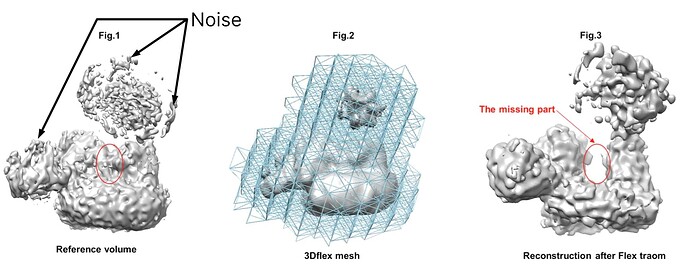In the process of 3D Flex training, there is a partial discrepancy between the map and the reference, the generated map noticeably lacks a portion of density when compared to the reference map I provided. What could be causing this?
Hi @XueyinZhou, I’ll try to help out with this. To start with, do you think you could provide images of your reference volume and the mask used to generate the 3D Flex mesh, as well as the map that you notice is missing a feature?
Hi, rposert, thanks for your willingness to help me. Fig1 is the volume I referenced, Fig2 is the 3Dflex mesh, and Fig3 is the map generated after training and 3d generation. I don’t know why there is a missing part in the middle after training.
Hi @XueyinZhou, I see what you mean about the discrepancy between the reference and the Flex volumes. However, I think the issue is more due to your particle stack rather than the Flex Train job itself.
I’ve indicated in the left panel of your image some types of noise that usually indicate there are still a significant amount of “junk” particles contaminating a particle stack. Junk particles usually cause the appearance of streaks, shells, or spikes of noise. We have another example of this type of noise in our guide.
In general, you want to remove as many of these junk particles as you can, since they’ll hurt the resolution of your reconstruction. 3D Flex is especially sensitive to junk particles, since it cannot add or remove map density, only move it between voxels. I think you might see an improvement in your map if you go back to particle curation jobs (like 2D classificaion, ab initio reconstruction, heterogeneous refinement, or 3D classification).
One final point about 3D Flex – generally, we would only expect that 3D Flex will improve a bad region of your map to, at most, look like the best region of your map. We would be surprised if 3D Flex improved the quality of the entire map to something significantly better than a consensus refinement.
For a concrete example, if you have a protein with a core region that resolves to 3.5 A and a flexible region that only resolves to 20 A in Non-Uniform Refinement, we would be surprised if 3D Flex improved the flexible region beyond 3.5 A (and indeed, we’d be impressed if that domain went to 3.5 A). I hope that helps to guide you to when 3D Flexible Refinement might improve your map, and in what ways you can expect to see improvements using this technique.
I’m happy to answer any more questions you might have!
Hi rposert, thank you for your response.
The noise region in the Fig.1 is actually the part I would like to improve. However, the improvement seems limited, and it has a relatively significant impact on the resolution of other important areas. Therefore, I would like to inquire if there are any methods to improve the resolution of the noise region while trying to maintain the resolution of other areas as much as possible, or at least minimize the impact on the resolution of other areas.
I can definitely point you in the right direction @XueyinZhou! I’ll provide more detail below, but based on the images you posted, I would expect that you’d see an improvement in the regions you indicate by using ab initio reconstruction and heterogeneous refinement to ensure you have a clean particle stack before proceeding with other techniques.
For particle curation in general, we would recommend following a procedure where 2D Classification is used to remove the most obvious junk picks, then ab initio reconstruction and heterogeneous refinement are used to clean up the particle stack in 3D. I have outlined this process here. Your case is obviously different from that one, since you do not have oligomerization to deal with, but the general procedure will remain the same.
Once you have a clean particle stack (that is, heterogeneous refinement generally shows you copies of the same class), you should try performing a homogeneous or non-uniform refinement. This is commonly called your “consensus refinement”.
If your GSFSC resolution here is better than 5 Å, we typically recommend trying 3D Classification, 3DVA, or 3D Flex to tease apart conformational differences. If it is worse than 5 Å, we typically recommend that more particle curation is performed, since it is likely there are still contaminating particles unrelated to
your target in the particle stack.
I hope that helps!
Hi rposert, I am following your advice and it seems to be very helpful. Thank you very much for your assistance. This really helped me a lot.
I’m glad you’re seeing improvement! Please do come back and post again if you run into any other issues!

